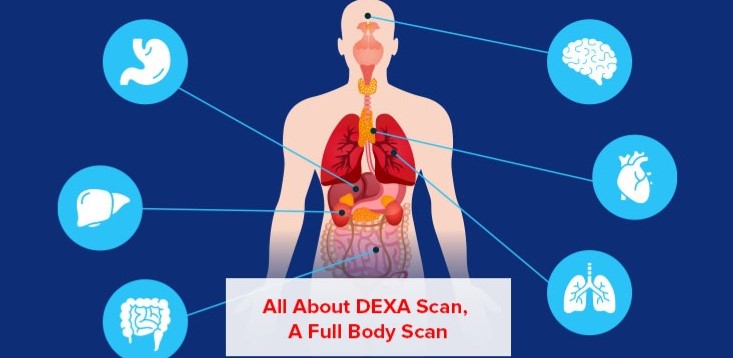DEXA or DXA stands for Dual X-ray Absorptiometry, also known as full body scan or density scan. This scan is capable of telling an in depth analysis of your fat tissue, lean mass and bone density. It is a painless and quick scan. This scan uses tow low energy X-ray beams which allows image to show both soft tissue and bone. With the help of DXA scan doctors can determine a person’s risk of fracture.
What Is DXA Scan Used For?
Healthcare providers use DXA/DEXA scan for-
- See and determine bone density to predict whether the patient is susceptible for fractures
- To diagnose bone diseases which alter bone metabolism for e.g. – osteoporosis, osteopenia etc.
- Track bone health changes over the course of time
- Evaluate body composition such as how much fat and muscle mass is present in your body
- To monitor your response to treatment such as for osteoporosis
- If you have thyroid condition, such as hyperthyroid
- If you have parathyroid condition such as hyperparathyroidism
- A man with clinical condition associated with bone loss, such as rheumatoid arthritis, chronic kidney or liver disease
- A post-menopausal women not taking estrogen\
- If you have maternal or personal history of hip fracture or smoking
- If you use medication that can cause bone los such as including corticosteroids eg- prednisone or anti-seizure medication such as Dilantin and certain barbiturates or high dose thyroid replacement drugs.
Osteoporosis and Osteopenia?
Osteoporosis is called known as “silent” disease since it doesn’t usually cause any pain. Many people realize that they have osteoporosis when the have broken bones even on minor falls.
Brittle bones having a high risk of fractures are known to be osteoporotic bones. Physiologically due to age bone tends to loose thickness and strength naturally also. Osteoporosis is a condition where bone loss is at faster rate than bone creation, otherwise bone deposition (formation) and resorption (bone loss) stays in harmony.
Osteoporosis literally means ‘porous bones’ DEXA scans are used to diagnose osteoporosis, keeping a track of your bone density and risks of having a broken bone over time
Most commonly post-menopausal women can have osteoporosis. Over the time bone becomes weak and brittle making them prone to fracture.
Osteopenia is a situation where “low bone mass” is seen. Thin, slender and very active individuals have low bone mass all their lives. But that doesn’t necessarily mean them having osteoporosis. Many athletes are thin and have low bone mass but their bones are healthy and strong. Osteopenia is not necessarily pre stage of osteoporosis but sometimes when a person has risk of fracture; an osteoporosis medication is recommended to help prevent future fractures
How Does The Procedure Work?
DXA machine is a thin and slender machine which emits invisible beam of low dose x-ray with 2 different energy peaks that goes through bones to examine then. One peak of beam is absorbed by soft tissues and other by the bones. That absorbed by Soft tissues can be subtracted from total and what remains is a patient’s bone mineral density.
Who Interprets The Results And How Do I Get The Report?
Only a specialized doctor who is known as a Radiologist reads the report and interprets radiology examinations. The radiologist will send a signed report to your primary care or will discuss the result with you directly. If the center where you have got your scan offers online report delivery, you can get the report online as well or else manually.
Summary
There area lot of bone disorders that lead into fracture which needs the correct diagnosis. For a correct diagnosis, you need to visit a center near to you and a center which is well equipped as well Ganesh Diagnostics is a great care provider to get yourself diagnosed, it having multiple full body bone scan centers in delhi. Osteoporosis and osteopenia are two commonly occurring disorders that are diagnosed by DEXA scan or bone density test.

